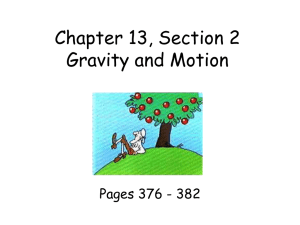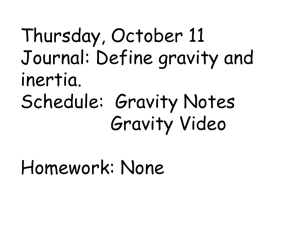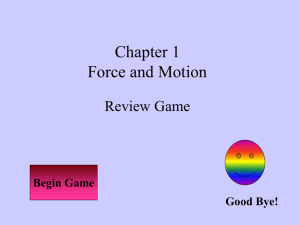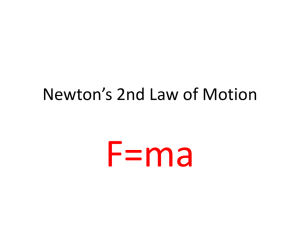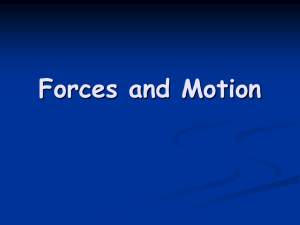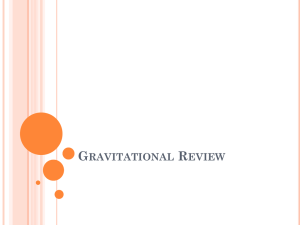Chapter 6: Forces and Motion - Red Hook Central School District
advertisement
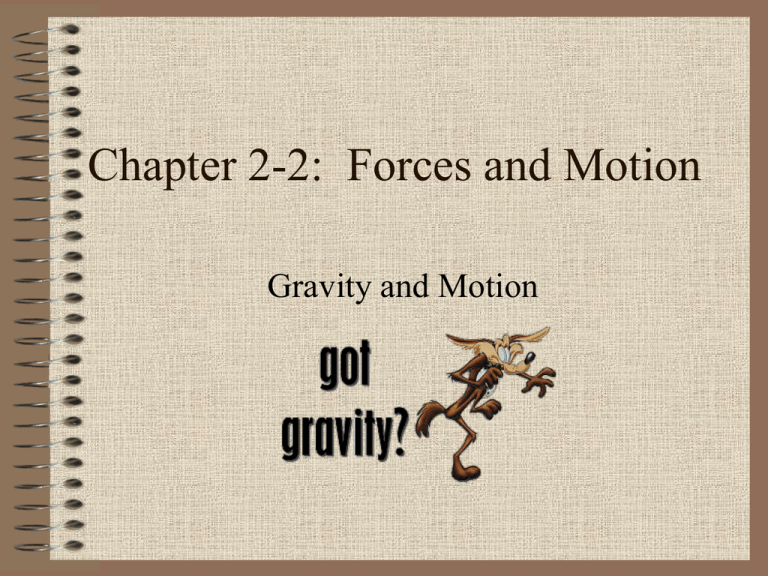
Chapter 2-2: Forces and Motion Gravity and Motion Effects of Gravity on Matter • Gravity – a force of _____________ between objects that is due to their masses • Gravity can affect the position of an object or the direction of the object’s motion. • All __________, because it has mass, is affected by gravity. Size of Earth’s Gravitational Force • Earth has a ______ mass in comparison to all other objects around you. • Earth has a ________ gravitational force. Newton and Gravity • Law of Universal Gravitation – all objects in the universe attract each other through gravitational force. The size of the force depends on the ____________ of the objects and the ___________ between them. • As mass increases, gravitational force increases. Weight • Weight – a measure of the gravitational force on an object – changes with position • Mass – the amount of matter in an object • If an object has more mass, then gravitational force is larger and they weigh more. • Where do you weigh more, on Earth or on the moon? Units of Weight and Mass • Weight is a force so it is measured in __________. • Mass is measured in _________ or kilograms Galileo Gravity and Acceleration • The acceleration on Earth due to gravity is the same for _______ objects. • Acceleration depends on both _________ and _________. • Heavier objects experience more gravity but they have more inertia, so they are more difficult to accelerate. Acceleration Due To Gravity • Acceleration is the rate at which velocity changes. • All objects accelerate toward Earth at a rate of 9.8 m/s2. • For every second an object falls, its velocity increases by 9.8 m/s. • In the 1st second, a falling object’s velocity is 9.8 m/s. In the 2nd second, it is traveling at a rate of 19.6 m/s. Velocity of Falling Objects • The following equation is used to find the change in velocity (Δv): • Δv = gravity • time • Try the practice problems in the Math Focus section on page 151. Air Resistance • Air resistance is the force that opposes the motion of objects through the air. • The amount of air resistance depends on the size, shape, and speed of the object. • The larger the __________ ________ of an object, the more air resistance acting on it. • How do parachutes help sky divers land safely? • They increase air resistance and slow the sky divers to a safe terminal velocity. Acceleration and Terminal Velocity • When the upward force of air resistance balances the downward force of gravity, the object stops accelerating. • The object then falls at a constant velocity called terminal velocity. • The terminal velocity of a human without a parachute is about 120 miles per hour. Free Fall with no Air Resistance • An object is in free fall if gravity is pulling it down and no other forces are acting on it. • Free fall can occur in a vacuum (a place where there is no matter) or in space. • Weightlessness is when objects are in a state of free fall. Astronauts float in orbiting spacecrafts because they are in a state of free fall. They have a sensation of weightlessness. Orbiting Objects • Two motions combine to cause orbiting motion: forward due to inertia and downward (free fall) due to gravity. • The moon stays in orbit around Earth because of the moon’s forward motion and Earth’s gravitational pull. • The unbalanced force that causes orbiting objects to move in a circular path is centripetal force. • Centripetal means “center seeking”. Projectile Motion and Gravity • Projectile motion – the curved path an object follows when it is thrown or propelled near the surface of the Earth. • Projectile motion has two components: horizontal motion and vertical motion, which are independent of each other. Projectiles • Gravity does not effect the horizontal motion of a projectile. • When you throw a ball, the horizontal velocity is constant. • Gravity does have an effect on the vertical motion of a projectile. • Gravity causes the vertical velocity to increase.

